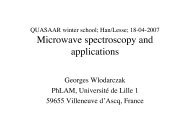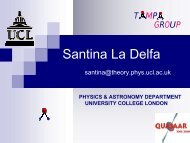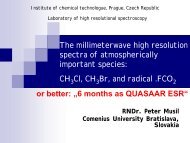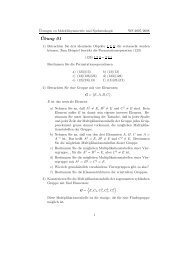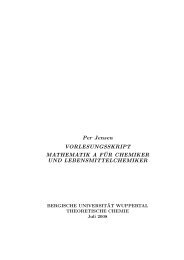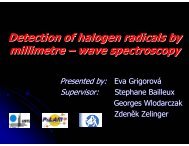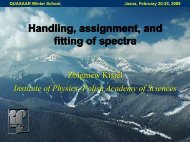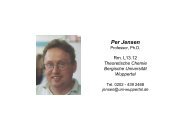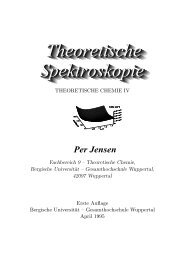Abstract book - Prof. Per Jensen, Ph.D. - Bergische Universität ...
Abstract book - Prof. Per Jensen, Ph.D. - Bergische Universität ...
Abstract book - Prof. Per Jensen, Ph.D. - Bergische Universität ...
- No tags were found...
Create successful ePaper yourself
Turn your PDF publications into a flip-book with our unique Google optimized e-Paper software.
Poster session, D28 75Preliminary modeling of CH 3 D from 4000 to 4550 cm -1Andrei V. Nikitin 1 , Linda R. Brown 2 , Michael Rey 3 , Vladimir G. Tyuterev 3 ,Keeyoon Sung 2 , Mary Ann H. Smith 4 and Arlan W. Mantz 51 Laboratory of Theoretical Spectroscopy, V.E. Zuev Institute of Atmospheric Optics, Tomsk,Russia, avn@iao.ru; 2 Jet Propulsion Laboratory, California Institute of Technology,Pasadena, CA U.S.A.; 3 Groupe de Spectrométrie Moléculaire et Atmosphérique, Universitéde Reims, Reims, France; 4 NASA Langley Research Center, Hampton, VA U.S.A.;5 Connecticut College, New London, CT 06320, U.S.A.Nikitin A.V.Brown L.R.Rey M.Tyuterev V.G.Sung K.Smith M.A.H.Mantz A.W.A new study of 12 CH 3 D line positions and intensities was performed for the upper portion ofthe Enneadecad polyad between 4000 and 4550 cm -1 . For this, FTIR spectra were recordedwith D-enriched methane samples (at 80 K with a Bruker 125 IFS at 0.005 cm -1 resolution andat 291 K with the McMath-Pierce FTS at 0.011 cm -1 resolution, respectively). Line positionsand intensities were retrieved by least square curve-fitting procedures and analyzed using theeffective Hamiltonian and the effective Dipole moment expressed in terms of irreducibletensors operators adapted to symmetric top molecules. Initially, only the cold spectrum wasused to identify quantum assignments and predict 12 CH 3 D relative intensities in this region.To assign higher quanta up to J equal 14, additional line positions and intensities wereobtained from two room temperature spectra. In the final stage, measured intensities fromboth the cold and room temperature data were normalized to corresponding values at 296 Kand averaged. Combining the two temperature datasets confirmed the assumed quantumassignments and also demonstrated the relative accuracies to be better than ±0.0002 cm -1 forline positions and at least ±6% for ~1160 selected features. Including additional assignmentsfrom the room temperature spectra alone permitted 1362 line intensities of 12 bands(involving 23 vibrational symmetry components) to be reproduced with an RMS of 9%. Over4085 selected positions for 12 bands were modeled to 0.008 cm -1 . Nevertheless a number ofknown assignments could not be modeled to within our experimental precisions. More workis needed to obtain a complete characterization of this complex polyad.This work is part of the ANR project “CH4@Titan” (ref: BLAN08-2_321467). Weacknowledge several sources of financial support: the LEFE-CHAT INSU project APOA1(CNRS, France); the Groupement de Recherche International SAMIA between CNRS(France), RFBR (Russia) and CAS (China); Program Number 22 The fundamental problemsof investigation and exploration of the Solar System of Russian academia of science. Part ofthe research described in this paper was performed at the Jet Propulsion Laboratory,California Institute of Technology, the NASA Langley Research Center and ConnecticutCollege under contracts and grants with the National Aeronautics and Space Administration.We thank the IDRIS computer centre of CNRS France and the computer centre Reims-Champagne-Ardenne and the computer centres of ICM@MG SB RAS (Novosibirsk) andSKIF Siberia (Tomsk).




